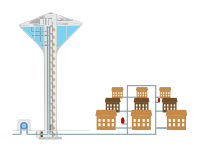
Photo from wikipedia
An experimental study was conducted to evaluate the efficiency of patch repair to rehabilitate corrosion-defected reinforced concrete (RC) beam-column members when exposed to bending moments and axial forces. Ten RC… Click to show full abstract
An experimental study was conducted to evaluate the efficiency of patch repair to rehabilitate corrosion-defected reinforced concrete (RC) beam-column members when exposed to bending moments and axial forces. Ten RC beam-column members were tested under combined constant axial force and four-point transverse load up to failure. Two levels of the constant axial force were applied at either 15 kN or 30 kN (i.e., 25% or 50% of the ultimate design load of the control specimen). The accelerated corrosion process was used to get steel reinforcement corrosion inside the concrete of three levels, 0% and approximately 5% and 20%, according to Faraday’s law. The patch repair technique of cleaning or replacing corroded steel bars and replacing the damaged concrete cover with new mortar was used in this study. The experimental results of the corrosion-defected specimens showed a significant deterioration in the structural performance and the integrity by reducing ultimate capacity, stiffness, serviceability, and ductility. Additionally, the effect of increasing axial force was recorded clearly by reducing the adverse effect of corrosion, especially for defected specimens with high corrosion level. The deterioration of corrosion reinforcement could be overcome when using a patch repair technique, which restored the undamaged state and was shown clearly by using a patch repair technique with replacing corroded steel bars.
Journal Title: Buildings
Year Published: 2019
Link to full text (if available)
Share on Social Media: Sign Up to like & get
recommendations!